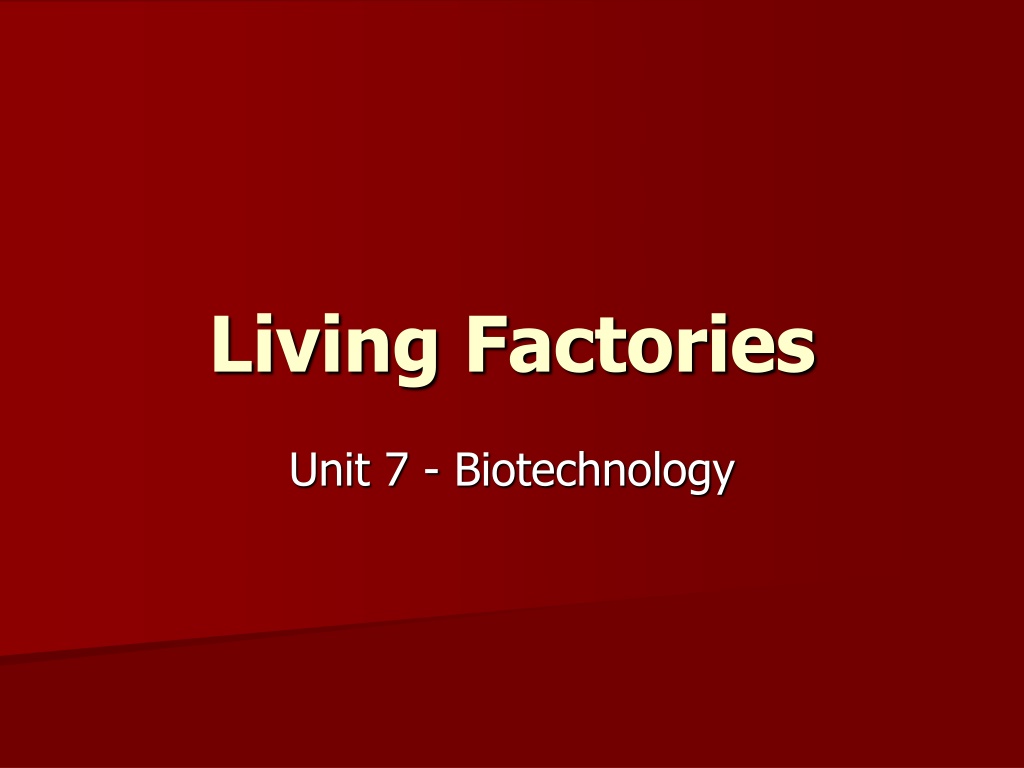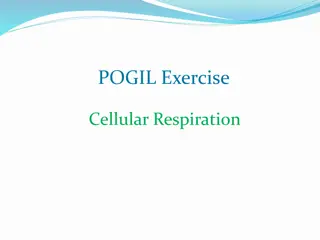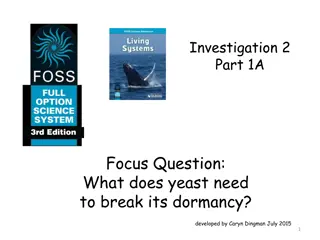Understanding Yeast: The Living Organism and Its Respiration Processes
Explore the world of Saccharomyces cerevisiae (yeast) as a single-celled fungus that exists on all living matter. Learn about its genetic similarities to humans, its basic survival needs, and the processes of aerobic and anaerobic respiration, including fermentation. Discover how yeast, like us, releases energy to survive and produce various by-products based on its respiration conditions.
Download Presentation

Please find below an Image/Link to download the presentation.
The content on the website is provided AS IS for your information and personal use only. It may not be sold, licensed, or shared on other websites without obtaining consent from the author. Download presentation by click this link. If you encounter any issues during the download, it is possible that the publisher has removed the file from their server.
E N D
Presentation Transcript
Living Factories Unit 7 - Biotechnology
Saccharomyces cerevisiae YEAST!!!
Yeast Single celled microorganism Type of fungus Exist on all living matter 16 chromosomes Hundreds of different species!
Did you know? We may not look much like yeast or they like us, but many of the 6,000 genes in yeast have counterparts in humans!
Yeast as a Living Organism As a living organism, just like us, yeast needs the following to survive and flourish: -sugars -water -warmth Respiration is the process by which a living organism releases energy from its food
Do you remember the difference between aerobic and anaerobic respiration?
Aerobic Respiration Humans produce energy through aerobic respiration In aerobic respiration glucose reacts with oxygen in the mitochondria of the cells to release energy. Carbon dioxide and water are by-products of the reaction.
Aerobic Respiration Glucose + oxygen carbon dioxide + water + energy
Anaerobic Respiration Anaerobic respiration occurs when oxygen is not available. In anaerobic respiration the glucose is only partially broken down, and lactic acid is produced
Fermentation Living yeast cells in the absence of oxygen are still able to use sugar as their source of food to make energy This is known as fermentation In this case ethanol (alcohol) is produced instead of lactic acid
Anaerobic Respiration (Fermentation) Glucose carbon dioxide + ethanol + energy
Aerobic Vs. Anaerobic Respiration Aerobic -oxygen always required -efficient method of respiration -sugar completely broken down to carbon dioxide and water
Aerobic Vs. Anaerobic Respiration Anaerobic -oxygen never required -inefficient method of respiration -releases a small amount of energy -much of the energy remains locked up in the molecules of the end product (e.g. the alcohol)
Quick Quiz Can you sort out the following statements into aerobic or anaerobic respiration? Just fill them into your table!
Glucose + oxygen carbon dioxide + water + energy Glucose reacts in the mitochondra of cells Much of the energy remains locked up in the molecules of the end product Inefficient method of respiration Sugar completely broken down to carbon dioxide and water Only releases a small amount of energy Glucose carbon dioxide + ethanol + energy Oxygen always required Oxygen never required Efficient method of respiration
Bread Basics! Bakers use two simple facts of life to create soft, spongy, moist bread: First, they use the fact that yeast (a single-cell fungi) will eat sugar: -from the sugar yeast creates alcohol and carbon dioxide gas as waste products -the carbon dioxide gas created by yeast is what gives bread its airy texture, and -the alcohol, which burns off during baking, leaves behind an important component of bread's flavor. 1.
Bread Basics! 2. Second, wheat flour, if mixed with water and kneaded, becomes very elastic. -the flour-and-water mixture in bread becomes stretchy like a balloon because of a protein in wheat known as gluten -gluten gives bread dough the ability to capture the carbon dioxide produced by yeast in tiny flour balloons.
Gluten http://www.exploratorium.edu/cooking/br ead/bread_science.html
How to make bread. You will need: Flour with added salt and lard rubbed in to make dough Yeast added to warm sugar solution and allowed to grow to produce bubbles Mix the yeast and the flour together in a bowl 1. 2. 3.
5. Leaving the mixture to rise Mixture left in warm place covered by damp cloth
6. Proving the dough Yeast releases CO2 bubbles making dough rise
7. Baking bread After dough rises a couple of hours in a warm place, it's ready to go into the oven. There, heat causes pockets of gas in the dough to expand
This powerpoint was kindly donated to www.worldofteaching.com http://www.worldofteaching.com is home to over a thousand powerpoints submitted by teachers. This is a completely free site and requires no registration. Please visit and I hope it will help in your teaching.























